Exhibition of works by Nikos Kessanlis as a tribute to the 10 +1 years since his death, under the title “City Walls”.
As a mark of honor to an artist who traced timely and opportune paths for contemporary art in our country by means of his work and his crafty personality, there comes this tribute to Nikos Kessanlis commemorating the 10+1 years since his death.
Kessanlis was a strong personality who encouraged artistic research, experimentation, collaboration, and the social dimension of art. An activist, an eccentric, a restless mind, an extremely creative being, an important artist, a tireless ambassador of the artistic creation in Greece and of the need for its ongoing dialogue with the international one, always in motion, communicatively skillful, an aggressive commentator, a cosmopolitan man, and, in general, an enfant terrible of the 1960s.
Intellectuals and historians have written thousands of pages on his work. I draw from the catalogue issued by the Macedonian Museum of Contemporary Art, 1997, quoting from the foreword by the curator, G. Tzirtzilakis:
(...) It is well known that, by cultivating an international language, Kessanlis opposed the figurative character of conformist painting, which, in the post war era, reproduced the mythologies of “the Generation of the 1930s”, especially the wearisome aestheticism of “Greekness” and the deadly enemy of every blend of creativity, the “good taste.” I recall here that the great adventure of the modern in our country began belatedly. Most of the undertakings between the wars were nothing but fumblings in the dark. Painting was still representing an ideal world, which distracted attention from the troublesome reality, that is, from the wall itself and the everyday world existing behind it. It will then be needed that the generation of the 1960s arrives, so that Greek art starts being dispensed from dullness, picturesqueness, and didacticism of ethography, and opens itself up to an explosive reality existing around us. (...)
Just for this aspect of his work only, which broke the impasses of "Greekness" in which the domestic contemporary art had been ensnared, and, in short, resolved our picturesqueness, we owe him a great deal.
The tribute to his work will take place in two parts with two exhibitions. The first one opens on Tuesday, February the 10th, 2015, under the title “City Walls”.
Here, handling matter is stronger, direct and pervasive. Fascinated by the suggestibility of walls as a substrate of life and the breath of the city, Kessanlis comes with violent gestures to detect the new metropolitan condition, which lends an unexpected character to the extensive urban surfaces.
It is a condition that, in our days of acute economic, social, and environmental crisis, takes on an emphatic character. In those works, the artist not only represents the multilayer and amorphous reality of the megalopolis, but converses with and, in a way, participates in it by multiplying the feelings and the possibilities of critical reception. Today, in those gestures by Kessanlis, we distinguish an experiential and precursor character, no less than a dialogue with the variations of artistic abstraction in the late 1950s, a time when the traces of the vast spread of megacities and of the "modern lifestyles” begin to become visible.
The second exhibition is scheduled to follow shortly after, and will be called “Friends”. It is dedicated to the cycle of works by the artist that the French art critic Pierre Restany has called “mec art”; in essence, it is about the phantasmagorias of identity, shadows and immortalizing captures of the artist’s friends.


















